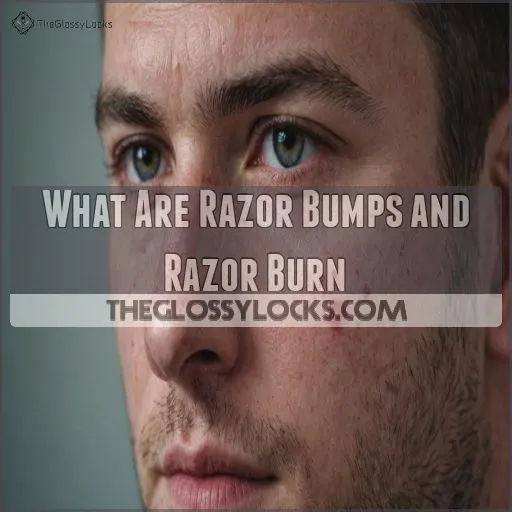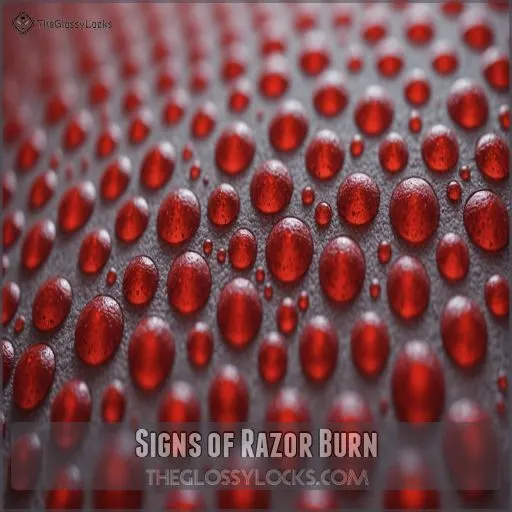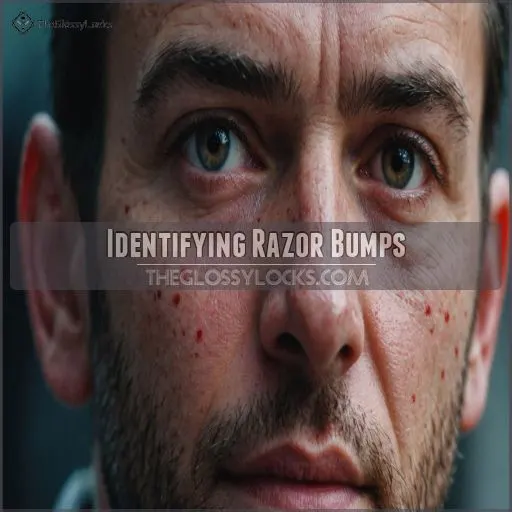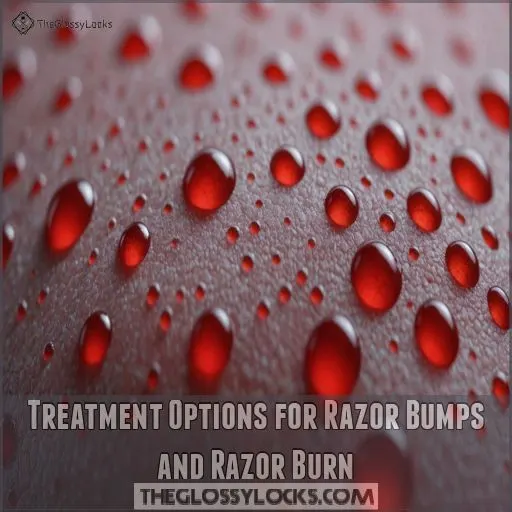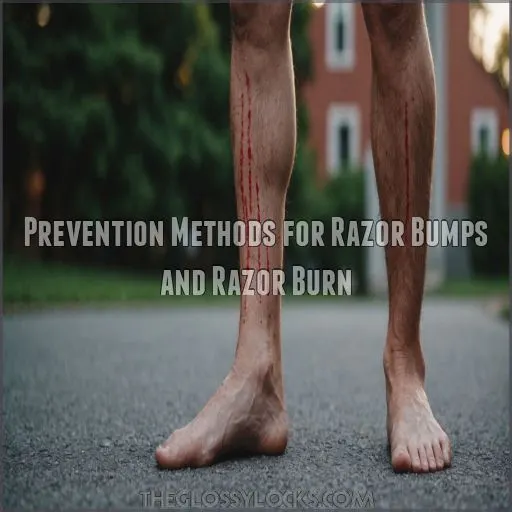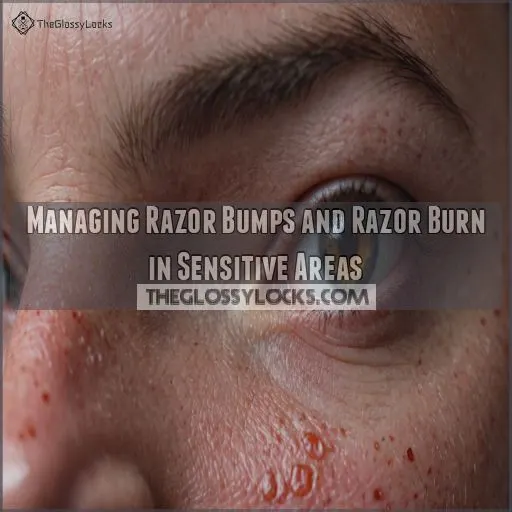This site is supported by our readers. We may earn a commission, at no cost to you, if you purchase through links.
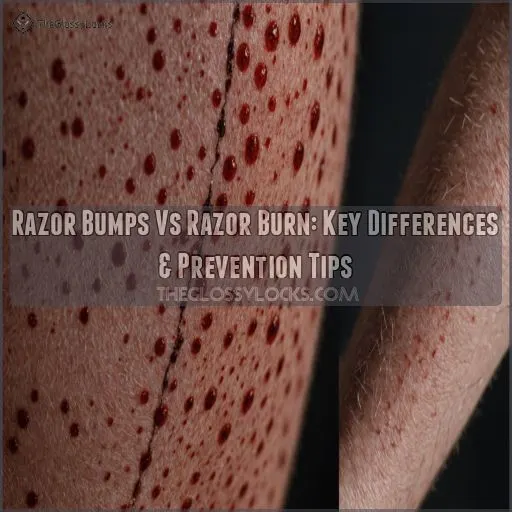
Razor burn is like an angry red rash that shows up right after shaving, causing itching and irritation. It’s your skin’s way of saying, "Ouch, that was rough!"
Razor bumps, on the other hand, are those pesky, pimple-like bumps caused by ingrown hairs. They’re the sneaky rebels that pop up a day or two later, often with a hair trying to break free.
While razor burn usually cools off quickly, razor bumps can stick around like unwanted guests. But don’t worry, there are ways to show both the door!
Table Of Contents
- Key Takeaways
- What Are Razor Bumps and Razor Burn
- Signs of Razor Burn
- Identifying Razor Bumps
- Treatment Options for Razor Bumps and Razor Burn
- Prevention Methods for Razor Bumps and Razor Burn
- Managing Razor Bumps and Razor Burn in Sensitive Areas
- Frequently Asked Questions (FAQs)
- What does a razor burn look like?
- What do razor bumps look like on a private area?
- How long does razor burn last?
- How to clear razor bumps?
- Are certain ethnicities more prone to razor bumps?
- Can razor bumps lead to scarring or skin discoloration?
- How long do razor bumps typically last?
- Are there any natural remedies for razor bumps?
- Can antibiotics help treat severe razor bumps?
- Conclusion
Key Takeaways
- You’re dealing with razor burn if you see an angry red rash right after shaving that feels like a fiery slide. It usually clears up in a few days, but it certainly itches in the meantime.
- Razor bumps are those pesky, pimple-like bumps that show up a day or two after shaving. They’re caused by ingrown hairs hiding under your skin and can stick around longer than razor burn.
- To prevent both, treat your skin like royalty. Exfoliate gently, use a sharp razor (no excavation tools, please!), and keep your skin hydrated. It’s like giving your skin a spa day every time you shave.
- If your razor woes are throwing a party that won’t end, especially in sensitive areas, don’t be shy about seeing a doctor. They’ve seen it all before, so there’s no need to feel as though you’re the only one battling the bumps!
What Are Razor Bumps and Razor Burn
Razor bumps and razor burn can make shaving a dreaded chore, but knowing the difference can save your skin (literally!).
While both are pesky byproducts of shaving, razor bumps are caused by ingrown hairs that turn your skin into a bumpy road, often requiring proper Razor Blade Care
.
Whereas razor burn feels like you’ve slid down a fiery slide with skin irritation and redness.
Definition of Razor Bumps and Razor Burn
Shaving can be tricky. Razor bumps, also known as pseudofolliculitis barbae, occur when shaved hairs become ingrown, causing irritation and inflammation, especially after improper shaving techniques
. On the other hand, razor burn is an unwelcome guest after shaving, greeting you with irritating red rashes.
- Ingrown hairs
- Skin irritation
- Razor bumps
- Razor burn
- Discomfort.
Common Causes of Razor Bumps and Razor Burn
Razor bumps and razor burn have a few sneaky culprits.
Your hair type, like curly hair, can encourage ingrown hairs, leading to razor bumps .
Shaving products and technique matter—using dull razors or skipping shaving cream can irritate your skin type.
Regular exfoliation and razor sharpness can help, but these pesky problems linger for many who shave frequently.
Symptoms of Razor Bumps and Razor Burn
You’ve mastered shaving prep, but razor bumps and burn can still crash the party. Symptoms are pretty clear:
- Razor Burn: Feel that tingling irritation akin to sunburn, coupled with redness and itching.
- Razor Bumps: Those unsightly, pimple-like bumps arise from ingrown hairs turning back on themselves.
- Easy to treat at home.
- Relief includes soothing balms.
Differences in Appearance of Razor Bumps and Razor Burn
Two telltale signs can help you distinguish razor bumps from razor burn.
Razor bumps tend to be larger, often with a white head and sometimes a hair poking through, while razor burn creates smaller, clustered red bumps similar to a rash.
Razor burn also typically clears up faster, within a few days.
Signs of Razor Burn
You know that annoying feeling when your skin flares up like it’s throwing a tiny tantrum?
That’s razor burn, and it lets you know it’s there with irritation, redness, and pesky little red bumps that scream for a quick fix.
But don’t worry—these symptoms usually pack up and leave within a couple of days, which is a quick fix.
Skin Irritation and Redness
Imagine your skin as the silent protester, waving fiery red flags when irritated by razor shaving.
You might notice skin irritation and redness post-shave, signaling razor burn. This common skincare hiccup appears as streaky blotches, tender to touch.
To tackle this, consider gentle shaving products and natural remedies, helping to quell the fiery rebellion of sensitive skin types (Source).
Itching and Burning Sensation
Ever had that unmistakable itching and burning sensation after shaving? Razor burn can feel like your skin’s throwing a tantrum.
To soothe this, try home remedies like aloe vera or a cool compress for itch relief.
Don’t forget, sensitive skin needs TLC—steer clear of irritating products. Keep things gentle to avoid irritation and enjoy smoother shaves.
Small Red Bumps and Tenderness
When those pesky small red bumps appear after shaving, you’ve likely encountered razor burn. This unwanted guest brings along skin irritation and tenderness.
To manage it:
- Switch Techniques: Shave with the grain.
- Hydrate Skin: Use aftershave products for sensitive skin.
- Exfoliate: Prevent ingrown hairs by gently exfoliating.
Remember, razor bumps needn’t crash your week.
Duration of Razor Burn Symptoms
Razor burn usually clears up within a couple of days, but it can sometimes hang around longer, like an uninvited guest.
To speed up recovery, use a fragrance-free moisturizer and avoid a dull razor.
If symptoms linger or worsen, it might be wise to consult a healthcare provider.
After all, taking care of your skin is a must!.
Identifying Razor Bumps
If you’ve ever wondered why those stubborn bumps appear after shaving,
you’re dealing with razor bumps caused by pesky ingrown hairs.
They might try to prank you by pretending to be pimples, but their common haunts are areas with coarse hair like your neck or legs.
Characteristics of Razor Bumps
You’ve tackled razor burn, now let’s talk razor bumps. These pesky, pimple-like bumps can make an appearance anywhere you’ve shaved.
Check these telltale signs:
- Bump location: Usually on the face, neck, and pubic areas.
- Bump color: Reddish or skin-toned.
- Ingrown hair: Hairs trapped under the skin.
- Puss-filled bumps: Sometimes, they’ve got tiny pus heads.
Stay savvy with these clues!
Ingrown Hairs and Inflammation
You ever wonder why ingrown hairs feel like unruly guests overstaying their welcome? They’re hairs that take a detour, growing back into your skin and causing inflammation.
Thankfully, keeping them at bay isn’t rocket science. Here’s a quick guide:
| Problem | Description |
|---|---|
| Ingrown Hairs | Hair curls under skin |
| Inflammation | Red, painful bumps |
| Hydrocortisone Cream | Reduces inflammation |
| Skin Care Tips | Exfoliate regularly |
These steps can transform your skin care game!
Difference Between Razor Bumps and Other Skin Conditions
Understanding the difference between razor bumps and other skin issues can help you regain control over your skincare.
While razor bumps result from ingrown hairs leading to pimple-like bumps, folliculitis involves infected follicles.
Acne and keratosis pilaris have different causes and should also be managed appropriately, as they differ from folliculitis.
Common Locations of Razor Bumps
Unlike acne or other skin conditions, razor bumps show up where you’ve shaved—a cheeky reminder of life’s little annoyances.
Picture your legs, pubic area, face, neck, and underarms as prime hotspots.
Each time you shave, particularly on coarse or curly hair, these bumps might pop up, inviting unwanted irritation.
Treatment Options for Razor Bumps and Razor Burn
When you’re dealing with razor burn or bumps, knowing the right treatment can save you from scratching like a DJ at a pizza party.
Learn how to soothe irritated skin and tackle those pesky bumps with remedies that work, so you can keep your cool and rock smooth, happy skin.
Soothing Remedies for Razor Burn
Imagine this: you’re battling razor burn like a knight defending a castle.
Use aloe vera for its soothing magic, or a cold compress for quick relief.
An oatmeal bath can quell the fiery itch, while witch hazel works like a potion to calm redness.
And hey, don’t forget a gentle aftershave to protect the skin from future skirmishes, with a little soothing magic.
Anti-Inflammatory Treatments for Razor Burn
For soothing razor burn, try anti-inflammatory treatments like aloe vera gel, which contains enzymes that can reduce redness and irritation.
Hydrocortisone cream or witch hazel can also help calm the skin . An oatmeal bath or cooling compresses may provide relief as well.
Be patient – your razor burn should clear up in a day or two, with aloe vera gel being one of the potential solutions.
Home Remedies for Razor Bumps
Ever wonder how to tackle those pesky razor bumps? Natural remedies like tea tree oil (diluted with a carrier oil) and soothing aloe vera can come to your rescue.
Using a sharp, high-quality razor can also help prevent razor bumps, as a dull razor can cause more irritation.
Additionally, shaving in the direction of hair growth is another effective way to minimize razor bumps.
Apply a witch hazel dab or try a baking soda paste for relief. These remedies offer gentle, effective ways to calm irritation and help your skin feel comfortable and smooth.
When to Seek Medical Attention
Though home remedies offer relief, sometimes razor bumps and razor burn play hard to get.
If you notice signs of infection, pus, severe pain, or symptoms that seem to be throwing a party that won’t end, it’s time to see a doctor.
Persistent bumps or worsening symptoms shouldn’t be ignored.
Keep your skin happy and consult a professional if needed.
Prevention Methods for Razor Bumps and Razor Burn
Preventing razor bumps and razor burn doesn’t have to feel like an endless quest, especially when mastering your shave with the right techniques and products for ingrown hair care
.
With the right techniques—like gentle exfoliation, proper shaving, and keeping your skin hydrated—you’ll soon see smoother skin and happier shaving experiences.
With the right techniques, you will be able to see a change and achieve smoother skin.
Exfoliation and Skin Preparation
You’ve nailed down your shaving routine, but those pesky razor bumps and burns still crop up. Let’s tackle the root cause with proper exfoliation and skin prep.
- Gently exfoliate with a natural scrub or brush to remove dead skin cells
- Open up pores with warm water or a hot towel
- Apply a pre-shave oil to soften hair and protect skin
Remember, don’t overdo it – exfoliate 2-3 times a week to keep your skin smooth and bump-free.
Shaving Technique and Razor Maintenance
If you want to prevent razor burn, your shaving technique is key.
Start by ensuring your razor is sharp and clean – a dull blade is a one-way ticket to irritation city .
Hold the razor at a 30-degree angle and use gentle, short strokes with the grain.
Don’t press too hard; let the blade do the work.
Remember, you’re shaving, not excavating your face!
Hydration and Moisturizing
Proper hydration is your secret weapon against razor woes.
Keep your skin well-moisturized before and after shaving to reduce irritation. Apply a gentle, alcohol-free moisturizer to damp skin post-shave.
This locks in hydration and creates a protective barrier. For an extra soothing boost, try natural oils like coconut or avocado.
Your skin will thank you with a smoother, bump-free finish, and proper hydration is the key to achieving this. Keep your skin well-moisturized to make a huge difference.
Avoiding Irritating Products
Ditch those harsh products that send your skin into a tizzy! When choosing shaving essentials, opt for gentle, fragrance-free options packed with natural ingredients. Your sensitive skin will thank you.
Steer clear of alcohol-based aftershaves that can leave you feeling like you’ve just doused yourself in fire. Instead, reach for soothing aloe vera or witch hazel to keep those pesky razor bumps at bay.
Managing Razor Bumps and Razor Burn in Sensitive Areas
Managing razor bumps and burn in sensitive areas can be tricky, but don’t worry – we’ve got you covered.
Whether you’re dealing with a pesky rash or stubborn ingrown hairs down there, we’ll walk you through the best ways to soothe, treat, and prevent these common shaving woes in your most delicate regions, particularly in areas with sensitive areas.
Private Area Care and Hygiene
Taking care of your private area isn’t just about looking good – it’s about feeling in your own skin.
Keep things clean and dry to avoid unwanted irritation.
After showering, gently pat the area dry and let it breathe before putting on clothes.
Opt for loose-fitting, breathable underwear to reduce friction.
Remember, a happy pubic zone means a happier you!
Gentle Exfoliation and Shaving Techniques
Gentle exfoliation is your secret weapon against razor woes in sensitive areas.
First, soften your skin and hair with a warm, steamy shower before using a soft brush or washcloth to lightly buff away dead skin cells.
When shaving, remember to go with the grain and use short, light strokes —slow and steady wins the race and keeps those bumps away.
Soothing Remedies for Sensitive Skin
After mastering gentle shaving techniques, it’s time to soothe that sensitive skin.
Your delicate areas deserve some TLC!
Aloe vera can be a real lifesaver, cooling and calming irritated skin.
Oatmeal baths work wonders too, providing relief from itching and inflammation.
For a quick fix, try cold compresses to reduce redness.
Witch hazel and coconut oil are also great natural remedies to keep in your arsenal for those post-shave blues, offering a gentle solution like Aloe vera.
When to Seek Medical Attention for Sensitive Area Issues
While most razor issues in sensitive areas heal on their own, some situations warrant a doctor’s visit.
If you’re losing sleep or struggling with daily activities due to discomfort, it’s time to seek help.
Also, watch out for signs of infection like pus, blisters, or a rash that lingers for weeks.
Remember, your doctor’s seen it all before, so don’t be shy about getting checked out, as they’ve seen it all before.
Frequently Asked Questions (FAQs)
What does a razor burn look like?
Imagine your skin as a battlefield after a fierce skirmish.
Razor burn looks like a red, inflamed warzone on your skin.
You’ll see irritated patches that may feel itchy or tender, resembling a sunburn’s aftermath (Source).
What do razor bumps look like on a private area?
Razor bumps in your private area look like small, red, itchy bumps or pimple-like spots.
They can appear a few days after shaving. They often appear along your bikini line or pubic region.
They can be tender and sometimes inflamed.
How long does razor burn last?
You’ll typically experience razor burn for 2 to 3 days, but it can linger up to 2 weeks in some cases . Don’t fret! With proper care, you’ll be smooth sailing in no time.
How to clear razor bumps?
Clear razor bumps fast by applying cool compresses, using aftershave or aloe, and moisturizing the area.
Keep skin clean to prevent infection. Consider using benzoyl peroxide or hydrocortisone from the drugstore for quick relief.
Are certain ethnicities more prone to razor bumps?
Yes, certain ethnicities are more prone to razor bumps.
Men of African ancestry have a higher risk, with about 45-80% affected.
However, it can occur in people of all ethnicities who shave or pluck hair.
Can razor bumps lead to scarring or skin discoloration?
Razor bumps can indeed lead to scarring and skin discoloration.
They may cause keloid scars or hyperpigmentation, especially if infected or picked at.
For darker skin tones, these issues are more noticeable and may require specialized care.
How long do razor bumps typically last?
Like a pesky houseguest, razor bumps can overstay their welcome.
You’ll typically endure these unwanted visitors for a few days to several weeks.
Patience is key—they’ll eventually pack their bags and leave your skin smooth again.
Are there any natural remedies for razor bumps?
You’ve got options for soothing those pesky razor bumps naturally.
Try applying aloe vera gel, coconut oil, or witch hazel to calm irritation.
A colloidal oatmeal bath can also work wonders for your skin.
Can antibiotics help treat severe razor bumps?
For severe cases of ingrown hairs and inflammation, antibiotics can indeed help treat razor bumps, similar to the soothing effects of hydrocortisone creams
.
Your doctor might prescribe topical or oral antibiotics to combat bacterial infections causing folliculitis.
However, they’re not always necessary for mild cases that often clear up on their own (Source).
Conclusion
Dealing with post-shave woes can be tricky, but understanding the difference between razor bumps and razor burn is your first step to smoother sailing.
Armed with the right knowledge and techniques, you can bid farewell to both these pesky problems.
Remember, prevention is key – treat your skin with care, choose the right tools, and don’t rush the process.
With a little patience and the tips we’ve shared, you’ll be well on your way to silky-smooth skin that’s free from both razor burn and razor bumps.

